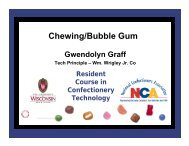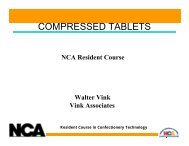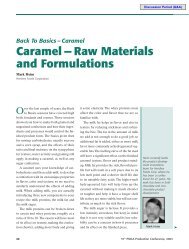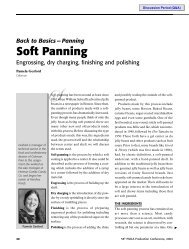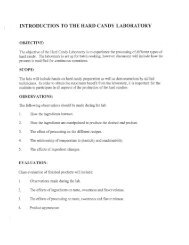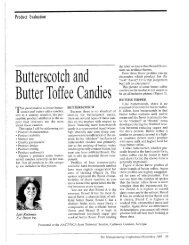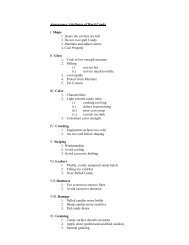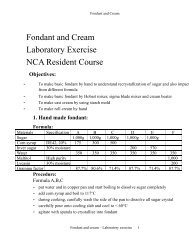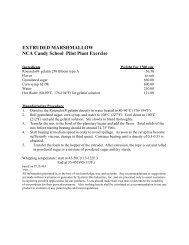2001 Grained and Ungrained Confections - staging.files.cms.plus.com
2001 Grained and Ungrained Confections - staging.files.cms.plus.com
2001 Grained and Ungrained Confections - staging.files.cms.plus.com
Create successful ePaper yourself
Turn your PDF publications into a flip-book with our unique Google optimized e-Paper software.
<strong>Grained</strong> <strong>and</strong> <strong>Ungrained</strong> <strong>Confections</strong><br />
The higher the<br />
sugar content of<br />
fondant, the<br />
higher the water<br />
activity, with the<br />
greater danger of<br />
mold growth<br />
<strong>and</strong> yeast<br />
fermentation.<br />
gives out heat. If this is not removed by<br />
cooling, the syrup temperature will rise,<br />
affecting the crystal size <strong>and</strong> amount of<br />
crystals formed. Generally the higher the<br />
crystallization temperature the larger the<br />
sugar crystals which are formed.<br />
This leads us to specific grained confections,<br />
which hopefully will reinforce these<br />
general factors.<br />
FONDANTS AND CREMES<br />
Fondants are the simplest of grained confections.They<br />
are normally based on sugar,<br />
although sugarfree ones based on maltitol or<br />
other polyols are being made.Their structure<br />
consists of sugar crystals dispersed in a saturated<br />
solution of sugar <strong>and</strong> other carbohydrates<br />
such as invert sugar <strong>and</strong> corn syrup.<br />
Those other carbohydrates are sometimes<br />
essential to the shelf stability of the product.<br />
Normally there is 50–60 percent sugar<br />
crystals dispersed in 40–50 percent syrup.<br />
Fondant recipes consist of three main<br />
ingredients: sugar, water <strong>and</strong> corn syrup.<br />
These are <strong>com</strong>bined with other ingredients<br />
such as invert sugar, fructose, sorbitol <strong>and</strong><br />
glycerol. Sometimes mold-inhibiting chemicals,<br />
such as sorbic acid, are added where a<br />
formulation gives a product with a water<br />
activity greater than 0.65.You can avoid this<br />
by using the correct formulation, if possible.<br />
Even with this simple recipe, there are<br />
many variables.<br />
Moisture Content<br />
The water content of the finished fondant<br />
is the most critical variable, because<br />
it affects the efficiency of using it, <strong>and</strong> its<br />
shelf life. Generally water content is in<br />
the range of 12–15 percent but should be<br />
controlled accurately, i.e., within ± 1 ⁄2 percent<br />
of that specified.<br />
Type of Corn Syrup<br />
Corn syrups now cover a wide range of <strong>com</strong>positions.<br />
The major <strong>com</strong>ponents are dex-<br />
trose, maltose <strong>and</strong> dextrins — mainly consisting<br />
of long molecular chains of dextrose.<br />
The quantity of dextrose <strong>plus</strong> maltose<br />
on a dry solids basis is expressed as dextrose<br />
equivalent (de). Now that enzymes<br />
are also used to produce corn syrup, it is<br />
possible to change the ratio of dextrose to<br />
maltose <strong>and</strong> achieve higher de. High-maltose<br />
<strong>and</strong> high-dextrose corn syrups can also<br />
be produced. In addition, it is possible to<br />
produce high-fructose syrups, which are<br />
sweeter.These are increasingly used in confectionery,<br />
although mainly in the beverage<br />
industry.<br />
High-de syrups have less dextrins in<br />
them; they are particularly important in<br />
fondants because they affect the viscosity<br />
<strong>and</strong> the crystallization of sugar from the<br />
fondant syrup. Low-de corn syrups lead<br />
to more viscous fondant syrups with slower<br />
crystallization of sugar from them, <strong>and</strong><br />
high-de corn syrups do the opposite. The<br />
choice of corn syrup therefore is a very<br />
important variable.<br />
Amount of Sugar<br />
The sugar content of the recipe,which<br />
increases the ratio of sugar to corn syrup,<br />
is a key variable.The higher the sugar content<br />
the more sugar crystals are formed<br />
<strong>and</strong> the harder the fondant, for a given<br />
water content.<br />
Amount of Other Materials<br />
The quantities of humectants, such as sorbitol,<br />
glycerol <strong>and</strong> invert sugar, are also<br />
important.They reduce the viscosity of the<br />
fondant syrup, increase sugar crystallization<br />
rates <strong>and</strong> lower water activity.<br />
Commercially available fondants are<br />
generally made to simple recipes, using<br />
sugar, water <strong>and</strong> 42 de acid-converted corn<br />
syrup. They are often referred to by the<br />
ratio of sugar to corn syrup, e.g., 8:1 fondant<br />
contains eight parts of sugar <strong>and</strong> one<br />
part of corn syrup.The soluble solids of the ➤<br />
46 55 th PMCA Production Conference, <strong>2001</strong>



